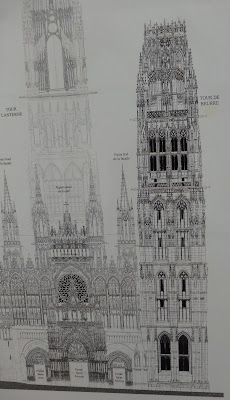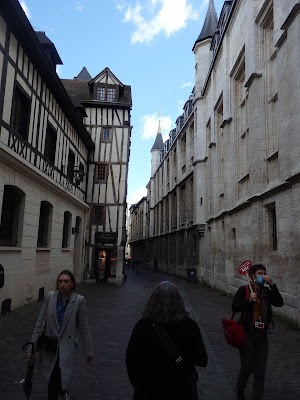The morning on October 6th we watched a presentation about the life of Joan of Arc. In the second half of the Hundred Years’ War between England and France, English forces occupied much of northern France, including Normandy and its capital. After Joan had inspired a series of successes against the English army south along the Loire, she was captured by Burgundians and ransomed off to the English. Joan was tried by French churchmen in English-ruled Rouen, who burned her at the stake in 1431.
 |
| After the presentation, we had lunch. Some of the menu was the same every day but there were also daily specials. |
After lunch the ship docked in Rouen, France.
At Rouen, we took the Rouen Walking Tour. The ship was docked by the Pont Boieldieu, or the Boieldieu Bridge. There are four sculptures on the bridge.
 |
| On the right bank, one sculpture represents the Rouen navigator and explorer Cavelier de La Salle at the head of an expedition to America while the other shows us Normans, sailing to England on an esnèque (drakkar). The sculptor was Jean-Marie Baumel. |
 |
Rouen's Notre-Dame Cathedral is the centerpiece of this historic town. It is impossible to get far enough way from the building to get a good photo. As you can see, each tower is built in a different style. Work on the closest one, The Butter Tower, begun in 1488. The Pope authorized Cardinal d'Amboise to grant dispensations to consume milk and butter during Lent, in exchange for contributions to the tower. The new tower soon took on the nickname of the Butter Tower, though the money collected paid only a portion of the cost. The spire, constructed of cast iron, was not finally completed until 1882
|
 |
| I know I have too many photos of the cathedral on this blog but you could spend all day just looking at all the details on the exterior of the building and another day looking at the interior. |
 |
| The Cathedral reaches almost 500 feet into the sky and dominates the city’s skyline. From 1876 to 1880, it was the tallest building in the world until the Cologne Cathedral stole its title. Today, it remains the tallest cathedral in France. The church is a prime model of Gothic architecture, with examples from the style’s various eras within its structure including Early (as seen in the nave) and Flamboyant (the Saint-Romain tower) to neo-Gothic (the spire). Each year, the city puts on the Cathedral of Lights show that further highlights its already stunning facade by illuminating the church with vivid images, lines and colors. |
 |
| The construction of the cathedral started in 1145 with the Tower Saint-Roman on the left. It was built in the new Gothic style. |
 |
| Across the street from the cathedral is the Rouen Normandy Tourist Office, housed in the oldest surviving Renaissance building in Rouen, dating back to 1509 and now labelled a historical monument. |
 |
| Next to the Tourist Office is the Grande Pharmacie du Centre, an Art Deco building that serves as a pharmacy. |
 |
| Then we head inside. They are doing some work on the cathedral so there's a net above to protect us from any falling objects. The ceiling is 92' over our heads. |
 |
| The south transept has a rose window from the 15th century. |
 |
| Wikipedia tells the story of how the cathedral was damaged during World War II. "At the beginning of World War II in 1939, remembering the damage caused to French cathedrals in World War I, the Cathedral authorities protected the sculpture of the cathedral with sandbags and removed the old stained glass and transported it to sites far from the city. Nonetheless, in the weeks before D-Day in Normandy, the cathedral was hit twice by Allied bombs. In April 1944, seven bombs dropped by the British Royal Air Force hit the building, narrowly missing a key pillar of the lantern tower, and damaging much of the south aisle and destroying two windows. In June 1944, a few days before D-Day, bombs dropped by the U.S. Army Air Force set fire to the Saint-Romain tower. The bells melted, leaving molten remains on the floor." |
 |
| The side aisles are 46 feet high |
 |
| Closer look at the rose window |
 |
| These sculptures have been taken inside to preserve them from the elements |
 |
| The Viking leader Rollo became first Duke of the Duchy of Normandy and was baptized in the Carolingian cathedral in 915 and buried there in 932. The Carolingian cathedral predates the present cathedral but occupied the same land. |
 |
| This tomb contains the heart of Richard the Lion-Hearted, Duke of Normandy and King of England (died 1199). He was crowned Duke of Normandy in Rouen. |
Eighteen small chapels are placed between the buttresses on the north and south sides of the nave. They are filled with art, sculpture and stained glass given by wealthy donors and the guilds of the city. Some of the chapels are very plain, while others are adorned with paintings and sculptures from the 17th and 18th centuries. The bombardment of the Catedral in 1944 destroyed the other five chapels on the south side of the nave; only the Chapel of Sainte-Catherine survived intact.
 |
| This drawing gives a better perspective on the height of the center spire |
 |
| We went out the north portal. Wikipedia tells us, "The north portal is similar in its plan to the north transept portal of Notre-Dame-de-Paris, built a few years earlier; the decoration of the portals spills over into the adjacent sections. Each portal has a column-statue between the doors, and is topped by a tympanum full of sculpture, and above that an arched voussure filled with three bands of statues. Above this a lace-like pointed gable, which rises upward in front of the windows of the claire-voie gallery as far as the rose window. A similar sculpted gable is placed over the rose window, just below the triangular gable of the transept roof. The embrasures of the doorway are also filled with delicate sculptural medallions." |
 |
| As we stepped out onto the street, we watched the tourist tram go by. |
 |
| Picture of the tourist tram found on the internet. |
 |
| Rouen has over 2000 old half-timbered homes. |
 |
| Ornate decoration along the top of the choir portion of the cathedral |
 |
| The back side of the spire. |
 |
| Close up of the ornate decorations. |
 |
| A museum in honor of Joan of Arc d'Arc is housed in the Archbishop's Palace next to the cathedral. This portrait was made by removing sooty buildup from the side of the building. |

 |
| Near the cathedral is Saint Maclou |
 |
| Victor Hugo famously described Rouen as ‘the city of a hundred spires' but his count was a little off. It's more like 125. |
 |
| Rouen's half timbered houses date from the 16th to 18th century. As you can see, this one is dated 1664 |
 |
| This one is more than a little crooked. |
 |
| A timber framed house is made up of a wooden framework and infill. Corbelling, enabling the creation of floors that overhang the ground floor, was developed in the 14th century. With the technique being perfected, it is still possible to see houses with two, three, or even four floors until they were banned in 1520 due to the beliefs about sanitation fears of the plague and fire propagation risks. |
 |
| Our walk took us to the shopping area which has has this distinction since medieval times. |
 |
| The Gros-Horloge (big clock) is emblematic of Rouen; a beautiful astronomical clock set within a Renaissance arch that stretches over the street bearing the monument’s name. Perched atop is its Gothic belfry tower, which houses one of the oldest clock instruments in Europe that allowed the monument to tell time non-stop from the 14th century up until 1928. |
 |
| The Joan of Arc Church is another structure that defies being photographed. Built in 1979, the sweep of the roof is supposed to resemble the flames that consumed the saint. |
 |
| A small commemorative plaque and a 65 foot high cross mark the spot on which Joan of Arc was burnt alive for heresy on May 30, 1431. |
 |
| Inside, 13 stained-glass windows from the 1520’s and 1530’s form a glass wall of over 5,400 square feet. These windows originally set in the choir of the Saint-Vincent Church which was destroyed during World War II. However, the windows had been removed from the church to prevent them from being destroyed. They were put into safe keeping until they were incorporated into the Joan of Arc Church some 40 years later. |
 |
| Walking back to the ship, we took a different route. These were the steps leading from the roadway down to quayside. Notice the metal trough on the left. These were installed to make the transport of bicycles easier. |
 |
| We never got close enough to the Gustave Flaubert Bridge for a good photo but this is the top of it. It is the highest lift bridge in the world. |






















































































No comments:
Post a Comment